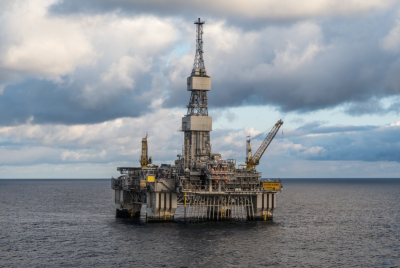A spill from state oil company Equinor’s Njord A platform in the Norwegian Sea is the first ever to reach land, and now it’s spreading northwards. Clumps of oil are turning up along the scenic Helgeland coast and threatening seabirds’ nesting areas.

“We are concerned about the oil pollution … especially for seabirds and otters that can be harmed by the oil,” said Ivar Myklebust of Norway’s environmental regulatory agency Miljødirektoratet after the oil first reached the coast of Trøndelag. Oil clumps, formed when the oil met cold water and then picked up sand and seaweed, were found around the island of Frøya, best known for its salmon farming and fishing industry.
Now many more oil clumps, some the size of a football, are also washing up farther north in Nordland County. They’ve been found at Sømna and Brønnøy and local officials are asking residents to be on the lookout for more and report them to NOFO, an oil industry association in charge of observation and documentation of oil pollution.
Myklebust, his colleagues and not least environmental organizations including Greenpeace are especially concerned over how the oil clumps are spreading just before the start of the spring nesting season. While Myklebust described the oil spill as “serious,” Halvard Raavand of Greenpeace publicly scolded oil company Equinor, which operates the Njord A platform and owns 42.5 percent of it along with partners Harbour Energy Norge AS, Vår Energi and Neptune Energy.
“On the one hand, the environmental agency says they’ve never had an oil spill like this before, while Equinor on the other hand says they weren’t aware of the extent of it until the oil reached land,” Raavand told news bureau NTB.
The spill itself occurred on New Year’s Eve but wasn’t made public until last week. Equinor has since reported that the spill was measured at around 150 cubic meters, roughly half of it oil and the other half “produced water.” The company also states that it deployed both a helicopter and five ships for surveillance purposes, to observe the oil slick that the spill created.
Equinor, which repeatedly refers to the spill as “unintentional” and as an “accidental discharge” on its website, claims that “after some time,” the oil slick was “no longer visible” and the surveillance operation was concluded. The company reports that it sent a “routine” report of the “incident” to state authorities including the Norwegian Ocean Industry Authority (Havtil) and the Norwegian Coastal Administration (Kystverket).
Equinor claims it was first informed by Kystverket that oil clumps had been found on Frøya on February 18. Analyses of the clumps confirmed that they originated from the Njord A platform on December 31. The platform itself has been in production since 1997 and also suffered a gas leak in 2011when Equinor was still known as Statoil. The company was later criticized for the spill and a lack of preparedness. The platform was only expected to produce until 2013, but Equinor has stated that “increased recovery rates and new discoveries near (its) oil and gas field have made it possible to extend the field’s economic life.”
Equinor is being held responsible for efforts to find and remove the oil from Njord that’s now reached land. “We are especially concerned about any oil reaching nature reserves in the Vega Islands (a UNESCO World Heritage Site), but also farther north in Helgeland where there’s valued nature with seabird colonies,” Myklebust told state broadcaster NRK this week.
Equinor claims it’s taking the spill “very seriously,” and is cooperating with NOFO on mapping and clean-up efforts. “Significant resources have been mobilized,” Equinor states, adding that this week, nearly 180 people are involved in manual clean-up and pollution monitoring. Equinor is also using five vessels and 20 drones to search for more oil clumps.
Equinor said it’s “maintaining close communication with the affected municipalities. The priority is to map and clean beaches before the nesting season begins,” to minimize the risk of birds coming into contact with the oil clumps.
Environmental advocates weren’t impressed. “The price for the weakness of Equinor’s security routines will be paid by vulnerable seabirds and other wildlife that’s now threatened by this terrible oil spill,” said Raavand of Greenpeace.
Lars Haltbrekken, a Member of Parliament who formerly led Norway’s chapter of Friends of the Earth, said it was “totally unacceptable” for Equinor to have such an oil spill. “After so many years of operating on the Norwegian continental shelf,” he told NTB, “they should have much better routines for making sure this doesn’t happen.” Haltbrekken has called for a full investigation into the spill.
NewsinEnglish.no/Nina Berglund
